Previous Chancellors
Bernadette Gray-Little
2009-2017
 Chancellor Gray-Little advanced KU's mission to educate leaders by implementing new admissions standards, launching a new undergraduate curriculum, and growing the freshman class for five straight years. She strengthened KU's efforts to build healthy communities by overseeing the University of Kansas Cancer Center’s application for National Cancer Institute designation and expansions of the schools of Pharmacy and Medicine. And she empowered KU to make discoveries by recruiting 12 Foundation Distinguished Professors, leading the university to record-high research funding, and pursuing resources to help KU researchers excel.
Chancellor Gray-Little advanced KU's mission to educate leaders by implementing new admissions standards, launching a new undergraduate curriculum, and growing the freshman class for five straight years. She strengthened KU's efforts to build healthy communities by overseeing the University of Kansas Cancer Center’s application for National Cancer Institute designation and expansions of the schools of Pharmacy and Medicine. And she empowered KU to make discoveries by recruiting 12 Foundation Distinguished Professors, leading the university to record-high research funding, and pursuing resources to help KU researchers excel.
Additionally, Chancellor Gray-Little led a record-setting $1.66 billion fundraising campaign and an unprecedented modernization of KU’s campuses. Under her leadership, KU completed 50 capital improvement projects totaling $700 million and secured funding for the Central District — a once-in-a-generation development project that will change the face of education and research at KU.
For more about Chancellor Gray-Little, visit our tribute page.
Robert Hemenway
1995-2009
 Chancellor Hemenway was a visionary leader who guided the University of Kansas to unprecedented successes during his time here. He took tremendous pride in making the university more student-focused, and under his leadership KU made improvements in how we educate students and provide them a world-class experience.
Chancellor Hemenway was a visionary leader who guided the University of Kansas to unprecedented successes during his time here. He took tremendous pride in making the university more student-focused, and under his leadership KU made improvements in how we educate students and provide them a world-class experience.
Chancellor Hemenway also guided the university to record-high research funding levels and helped position KU as a major player in the Kansas City life sciences and information technology industries. It was Chancellor Hemenway who made achieving National Cancer Institute designation for the KU Cancer Center the university's top priority. Additionally, he oversaw a resurgence of our athletics program, a record-setting fundraising period for the university, and a number of crucial capital improvement projects on the Lawrence, Edwards and KU Medical Center campuses that have greatly benefited our university.
Most importantly, Chancellor Hemenway, who always preferred being called “Bob,” was a wonderful and friendly man who loved his job, loved the people around him, and loved this place — and he was loved in return. A former English professor turned administrator, he never lost his passion for teaching and scholarship. For that, and for countless other reasons, he will forever be a wonderful role model for our students, faculty and staff.
Chancellor Hemenway passed away in August 2015 at the age of 73.
Del Shankel
1994-1995 and 1980-81
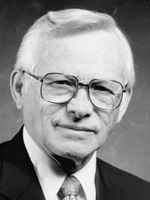 Delbert M. “Del” Shankel was the only individual to serve as KU’s chancellor twice. He was acting chancellor for the 1980-81 academic year, and in 1994 he was interim chancellor for seven months before the Kansas Board of Regents designated him chancellor. In 1995, he left that role and was granted chancellor emeritus status.
Delbert M. “Del” Shankel was the only individual to serve as KU’s chancellor twice. He was acting chancellor for the 1980-81 academic year, and in 1994 he was interim chancellor for seven months before the Kansas Board of Regents designated him chancellor. In 1995, he left that role and was granted chancellor emeritus status.
In addition to serving as chancellor, his roles included acting chair of the microbiology department, half-time assistant and later half-time associate dean for the College of Liberal Arts & Sciences, special counselor to Chancellor Budig, acting athletic director and interim president and CEO of the KU Alumni Association. He also has the distinction of being the university’s first executive vice chancellor.
Throughout his academic and administrative career, Chancellor Shankel remained devoted to his scientific discipline of microbiology. He maintained an active laboratory program and advised countless master’s and doctoral students. He was the consummate university professor, fostering interdisciplinary communication whenever he could. He once told a newspaper reporter, “I didn’t have a leadership career plan. I thought if I could become a good teacher, professor and researcher, I’d be happy.”
In recognition of Chancellor Shankel’s five decades of service to KU, in 2010 the university named the Shankel Structural Biology Center as a lasting tribute to him.
Shankel passed away in July 2018 at the age of 90.
Gene A. Budig
1981-1994
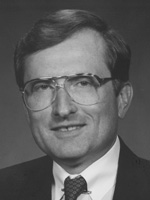 Gene Budig was named the university’s 14th chancellor in 1981. On the day he accepted the job, he said he aimed “to help a great public university become greater” — a goal he undoubtedly achieved over the next 13 years as chancellor.
Gene Budig was named the university’s 14th chancellor in 1981. On the day he accepted the job, he said he aimed “to help a great public university become greater” — a goal he undoubtedly achieved over the next 13 years as chancellor.
An experienced university administrator as well as a major general in the Air National Guard, Chancellor Budig presided over an impressive amount of physical growth on campus, including the Dole Human Development Center, the Adams Alumni Center, the KU Vietnam Veterans Memorial, the Anschutz Science Library, the Lied Center for the Performing Arts, and the opening of the KU Edwards Campus in Overland Park.
Under Chancellor Budig’s leadership, KU enrollment reached an all-time high of 29,161 in 1992, the KU Medical Center returned to sound financial footing, and the number of distinguished professorships at KU nearly tripled.
Additionally, Chancellor Budig helped lead KU through Campaign Kansas, a five-year fund drive that brought in $265 million in gifts and commitments. During his chancellorship, annual giving for KU's benefit rose from about $12 million to $34.6 million.
In 1991, tragedy struck the campus when lightning caused one of the KU’s oldest and best-loved landmarks, Hoch Auditorium, to burn, leaving only the historic facade. But through Chancellor Budig’s tireless lobbying efforts, KU received an $18 million appropriation from the state to rebuild the structure. In recognition, the new building was christened Budig Hall when it was officially dedicated in 1997.
Chancellor Budig resigned in 1994 to become president of Major League Baseball's American League – an unsurprising next chapter for a man with an unabashed lifelong passion for baseball.
Before leaving the university, Chancellor Budig told the Oread magazine, “I will leave the university with a sense of satisfaction and appreciation. Many things have been made better, and it has been the highest honor to be associated with the people of KU. Lawrence will always be special to our family. It is home.”
Chancellor Budig passed away in September 2020.
Archie Dykes
1973-1980
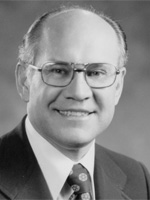 An experienced administrator and former University of Tennessee chancellor, Chancellor Dykes presided over enormous growth as the university's operating budget rose from $98 million to $250 million.
An experienced administrator and former University of Tennessee chancellor, Chancellor Dykes presided over enormous growth as the university's operating budget rose from $98 million to $250 million.
During his time as chancellor, enrollment and faculty salaries spiked, and $150 million in capital improvements were completed. Additionally, continuing-education course offerings were expanded dramatically.
Chancellor Dykes left KU in 1980 to run Security Benefit Life insurance -- but that did not mark the end of his service to higher education in Kansas. In 1982, he was named a Regent for the State Universities of Kansas, making him the only former administrator to receive this honor from the governor. The alumni of the University of Kansas also recognized his achievements by awarding him their highest honor, the Fred Ellsworth Medallion.
Dykes Library on the KU campus is named in his honor.
Raymond Nichols
1972-1973
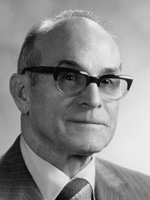 Executive secretary to five chancellors over 40 years at KU, Nichols was appointed first as acting chancellor after Chancellor Chalmers resigned, then given the full title until new Chancellor Archie Dykes was hired.
Executive secretary to five chancellors over 40 years at KU, Nichols was appointed first as acting chancellor after Chancellor Chalmers resigned, then given the full title until new Chancellor Archie Dykes was hired.
During his 44 years of service to KU, he witnessed and influenced major changes on the Lawrence campus. In the early 1920s, when Nichols arrived at KU to study journalism from his hometown of Larned, Jayhawk Boulevard was a dirt road. About 3,500 students were enrolled at the university.
Nichols earned a bachelor's degree in journalism in 1926 and a master's in journalism in 1928, both from KU. As a student, he was named to the Phi Beta Kappa honor society and he was editor of the University Daily Kansan, the student newspaper, and the Jayhawker, the university yearbook. He also reported for the Larned Tiller and Toiler and Kansas City Kansan newspapers.
In 1929, Nichols joined the KU staff as executive secretary to the chancellor, where he served until 1938. From 1938 to 1972, he worked as executive secretary to the university. In 1962, he became the university's first vice chancellor for finance, serving through 1969. In 1969, he received KU's Distinguished Service Citation, and, in 1977, he received the Fred Ellsworth Medallion, the KU Alumni Association's highest award for service to the university. After his retirement, Nichols' interest in keeping KU history alive inspired him to propose an oral history project to the KU Retirees' Club. The project includes the voices and words of people who have lived and worked at KU.
At the 1973 convocation, Nichols said, "The University of Kansas is greater than any single individual or group. It has reached its level of recognition by its ability to steer a steady course through good times and bad. ... Our business is young people; our business is to convert young men and women to mature men and women, creating the kinds of men and women who will take their places in greater society as responsible and creative individuals."
Raymond Nichols Hall, KU's Space Technology Center, was named for Nichols in 1976.
He passed away in October 1999 at the age of 95.
E. Laurence Chalmers
1969-1972
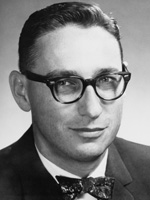 Chancellor E. Laurence Chalmers was known for giving students a voice and keeping peace during a turbulent period in the university's history. While brief, his chancellorship had a profound effect on the KU community.
Chancellor E. Laurence Chalmers was known for giving students a voice and keeping peace during a turbulent period in the university's history. While brief, his chancellorship had a profound effect on the KU community.
A psychologist, Chalmers was challenged to keep the peace in 1970 after an arsonist struck the student union and racial tension caused two deaths on campus. He averted a student strike by agreeing to grading options that allowed KU to complete the academic year. But the Board of Regents felt he was too permissive and tried to oust him. He resigned later to lead the Chicago Art Institute.
In August 2015, the university renamed the Art & Design Building as “E. Laurence Chalmers Hall” to commemorate a chancellor who embodied resiliency in times of hardship. At that building dedication ceremony, then-Chancellor Gray-Little said this of Chancellor Chalmers:
"Leaders frequently are confronted with challenges to which there are no simple or clear solutions. And the testament of a true leader is acting in the best interests of an institution, no matter how those actions might be viewed in the short term, or that they might upset some people. Chancellor Chalmers made difficult and sometimes polarizing choices during the days when the very fabric of our university was at risk. But the passage of time and the arc of history has helped crystallize the effects and outcomes of his chancellorship, and it has made clear that his legacy of inclusion, his ability to speak truth to power, and his willingness to make hard choices in the face of significant opposition, are truly deserving of the recognition we give him today."
W. Clarke Wescoe
1960-1969
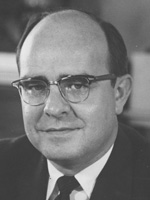 A popular chancellor who once sang his Commencement speech, Wescoe led the university through one of the most challenging and turbulent periods in its history, defusing explosive campus unrest and responding to the near doubling in enrollment.
A popular chancellor who once sang his Commencement speech, Wescoe led the university through one of the most challenging and turbulent periods in its history, defusing explosive campus unrest and responding to the near doubling in enrollment.
During Wescoe's tenure at KU, the university experienced unprecedented growth, with enrollment nearly doubling from 10,000 to more than 17,500, and saw state appropriations grow from $13 million to more than $26 million. Research grants to the university also grew, from $4.6 million in 1960 to $15.8 million in 1969. More than $43 million in new buildings were erected while he was chancellor -- including most of the Daisy Hill residence halls -- and he undertook an $18.6 million campaign for private support, then the university's largest capital gift campaign. Additionally, Wescoe increased faculty appointments and reorganized university governance bodies to include student membership.
Wescoe first joined the KU faculty in 1951 as a professor of pharmacology at the medical center in Kansas City, Kan. One year later at age 32, he was named dean of the School of Medicine, the youngest medical dean in the nation. In 1960, he was named chancellor.
In 1969, Wescoe resigned to become vice president for medical affairs and research at Sterling Drug Inc. and, in 1985, retired as chairman of the board and chief executive officer of that company.
Two structures on KU's campuses are named in Wescoe's honor: Wescoe Hall, KU's humanities building in Lawrence, and Wescoe Pavilion at KU Medical Center. His alma mater, Muhlenberg College, renamed its Evening College as the Wescoe School of Professional Studies.
Wescoe died in 2004 at the age of 83.
Franklin Murphy
1951-1960
 Murphy was dean of the KU School of Medicine when, at age 35, he became chancellor. Upon assuming the position, Chancellor Murphy made clear he had grand plans for KU. He was determined to make KU one of the nation’s great educational institutions.
Murphy was dean of the KU School of Medicine when, at age 35, he became chancellor. Upon assuming the position, Chancellor Murphy made clear he had grand plans for KU. He was determined to make KU one of the nation’s great educational institutions.
His vision of greatness included an expansion of KU's physical plant, as well as increases in its library holdings and technological and scientific equipment. He called for higher faculty salaries, and he wanted KU to place greater emphasis on research, which would pay dividends not only to the people of Kansas, but he believed, to the world as well. He also set to work expanding KU Medical Center's efforts to improve health in Kansas, especially in rural communities.
Naturally, Murphy’s vision of greatness required money, and lots of it. But then-Governor George Docking did not share Murphy’s vision or viewpoint. By the spring of 1960, a nearly four-year feud between Chancellor Murphy and Governor Docking had reached the breaking point. On March 17 of that year, an exasperated Murphy finally resigned and announced he would leave KU to become chancellor of UCLA. That night, some 600 students hanged and burned Docking in effigy. The next day, over 4,000 gathered in Hoch Auditorium to support Murphy and to express their disgust with his rough treatment at the hands of the governor.
Deane Malott
1939-1951
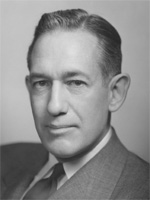 When Deane W. Malott agreed in the spring of 1939 to leave his professorship at Harvard and become the eighth chancellor at the University of Kansas, observers quickly dubbed him the “Chancellor of Firsts.” Not only was he the first native Kansan to hold the top office, but he was also the first former graduate, having earned an economics degree from KU in 1921. Furthermore, Malott was the first chancellor to have extensive business experience, something most agreed was going to be an asset in the formidable task of righting his undergraduate alma mater after an unhappy decade of economic depression and academic listlessness.
When Deane W. Malott agreed in the spring of 1939 to leave his professorship at Harvard and become the eighth chancellor at the University of Kansas, observers quickly dubbed him the “Chancellor of Firsts.” Not only was he the first native Kansan to hold the top office, but he was also the first former graduate, having earned an economics degree from KU in 1921. Furthermore, Malott was the first chancellor to have extensive business experience, something most agreed was going to be an asset in the formidable task of righting his undergraduate alma mater after an unhappy decade of economic depression and academic listlessness.
Malott used his business experience to guide the university through the lean World War II years by training and housing military recruits, and by evolving KU's curriculum to meet wartime training needs. In the boom years that followed the war, Chancellor Malott skillfully led KU's efforts to address skyrocketing enrollment and resulting strains on classrooms and housing.
Additionally, Malott’s legacy at KU includes the construction of 10 new campus structures, the establishment of Navy ROTC in 1946, the conversion of the old Fowler Shops into the new William Allen White School of Journalism, the fundraising and organizational drive to construct the Memorial Carillon and Campanile, and financial achievements such as convincing the state to more than quadruple the university’s annual budget and raise faculty salaries by nearly 50 percent.
In 1951, he resigned to become the sixth president of Cornell University.
Ernest Lindley
1920-1939
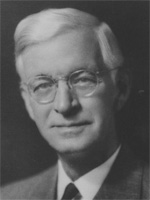 A psychologist, philosopher and University of Idaho president, Lindley worked closely with the Kansas state legislature to secure an unprecedented $3.5 million building allotment for the University of Kansas in his first year as chancellor. With these and future appropriations, Lindley oversaw a major campus construction boom that included Strong Hall, Watson Library, Hoch Auditorium, New Snow Hall, the Kansas Memorial Union, Memorial Stadium, and the University’s first dormitory for women, Corbin Hall.
A psychologist, philosopher and University of Idaho president, Lindley worked closely with the Kansas state legislature to secure an unprecedented $3.5 million building allotment for the University of Kansas in his first year as chancellor. With these and future appropriations, Lindley oversaw a major campus construction boom that included Strong Hall, Watson Library, Hoch Auditorium, New Snow Hall, the Kansas Memorial Union, Memorial Stadium, and the University’s first dormitory for women, Corbin Hall.
Chancellor Lindley also holds the distinction of having survived a concerted political effort to secure his ouster. The saga involved a nearly epic battle against Governor Davis, rough treatment at the hands of the Board of Administration, his termination and then reinstatement as chancellor, and his role in getting the landmark Regents Bill signed into law.
Lindley’s career as chancellor of KU lasted another 13 years, until 1939. All indications suggest much of his remaining time on the hill was acutely unpleasant. The Great Depression hit Kansas hard, and the university stumbled through the period on the shakiest of financial grounds. Lindley had served in the best of economic times and the worst of economic times. He resigned effective June 30, 1939, and then embarked upon a vacation with his wife Elizabeth. They toured the Far East, including Japan, China, and India. Lindley never made it home alive. He died on August 21, 1940, and was buried at sea.
Frank Strong
1902-1920
 A New York native, Yale graduate and president of the University of Oregon, Chancellor Frank Strong stormed onto campus declaring that KU was woefully inadequate and that much more money was needed. In return, KU would graduate students capable of solving the state's economic and industrial problems, he said. Chancellor Strong won increased funding and founded the schools of Education, Journalism and Medicine and expanded extension programs.
A New York native, Yale graduate and president of the University of Oregon, Chancellor Frank Strong stormed onto campus declaring that KU was woefully inadequate and that much more money was needed. In return, KU would graduate students capable of solving the state's economic and industrial problems, he said. Chancellor Strong won increased funding and founded the schools of Education, Journalism and Medicine and expanded extension programs.
He also had the distinction of presiding over KU when the United States entered World War I, at which point KU faculty, administrators and students rushed to pledge their assistance, their energies and, if necessary, their lives to support President Wilson and the nation’s war efforts. Even Chancellor Strong, a longtime opponent of on-campus military training, committed his full and unconditional support. Strong delivered a speech titled “Mobilization at the University” before the National Council of Defense in Washington, DC, on May 4, 1917. His address, in which he explained the past month’s developments at KU, showed how the University of Kansas was “attempting to make itself fully available for the service of our common country.”
Strong’s generally upbeat and positive appraisal of how KU was coping with and contributing to the war effort sounded good. But in the end, chaos, apathy, and misfortune were what most characterized the University’s wartime experience. In the first place, while military training at KU began with a good deal of enthusiasm among the students, it quickly became a serious annoyance and eventually descended into farce.
The First World War ended abruptly on November 11, 1918. These failures at KU had no measurable effect on America’s war effort. The war had, however, taken its toll on Chancellor Strong. He later recalled “the death of so many that had been students during my administration, and the calamitous history of the Students’ Army Training Corps, with the appalling list of those who succumbed to the Spanish influenza.”
These tragedies, he said, had “caused personal shock from which I found it very difficult to recover, and helped produce an overwhelming desire to be relieved from the responsibilities attaching to the office.” Strong resigned a year later, on September 13, 1919.
Francis Snow
1890-1901
 In 1866, Snow became one of the first three faculty members at the fledging University of Kansas, in a state that had only entered the Union five years earlier. During his career at KU, which would span nearly 40 years, Snow became one of the nation’s most eminent natural scientists before becoming chancellor in 1890.
In 1866, Snow became one of the first three faculty members at the fledging University of Kansas, in a state that had only entered the Union five years earlier. During his career at KU, which would span nearly 40 years, Snow became one of the nation’s most eminent natural scientists before becoming chancellor in 1890.
As chancellor, Snow presided over the abolition of the preparatory department and the creation of the College of Arts and Sciences, and the Schools of Engineering, Law, Fine Arts, and Pharmacy. He was an unflagging advocate of KU throughout the state and nation, a staunch defender of academic freedom, and contributed mightily to KU’s transition from college to university. During his watch, enrollment more than doubled (from 505 to 1,154), six new buildings were erected (including the Snow Hall of Natural History), the faculty increased from 34 to 79, and the University’s library holdings went from 14,000 to 38,000.
In 1897, perhaps the single most important development of Snow’s tenure occurred, an achievement that further helped rank KU as one of the nation’s mature universities. In that year, KU established the Graduate School and formally began a PhD degree program. According to observer Clifford Griffin, this move was “the University’s greatest glory, … for it was the highest degree known and was given both by the great German institutions and a growing number of prestigious American schools,” such as Harvard, Yale, and Columbia. The Graduate School’s “existence raised the University from a merely undergraduate school to one of the very highest learning.”
Joshua Lippincott
1883-1889
A clergyman described as pious and moralistic, Lippincott eliminated the preparatory department, establishing KU as a true university. Soon Phi Beta Kappa and Sigma Xi scholastic honorary societies established at KU their first chapters west of the Mississippi River.
Lippincott attracted notable graduates to teach at KU but, dismayed by continuing budget cuts, he left to become pastor at a Topeka church.
James Marvin
1874-1883
A Methodist minister, Marvin succeeded in getting Kansas high schools to adopt curricula that would ensure KU could teach classes at a college level instead of a prep-school level. Despite budgets slashed because of drought, a grasshopper invasion and a silver panic, Marvin won funds for improvements, including a chemistry building and a stone wall to keep out wandering livestock.
John Fraser
1867-1874
The Civil War veteran and prisoner of war gained administrative powers and presided over steady growth in the number of students and faculty. A second building, boasting central heat, electric lights and running water, opened. He left to serve as Kansas Superintendent of Public Instruction.
R.W. Oliver
1865-1867
As the first chancellor, Oliver's duties overseeing the 40-acre, one-building school were never clearly established by the Board of Regents, except that he was barred from directing the three faculty members. Frustrated, the Civil War chaplain and Episcopal minister soon departed to pursue church work.